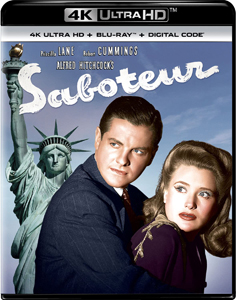“Saboteur” (1942) gets somewhat lost among the great Alfred Hitchcock films. It is one of many about a common man who becomes a fugitive because of idiotic law enforcement, works to catch the bad guys on his own, and somehow finds time for romance with the woman who doubts him.
The first thing that makes “Saboteur” stand out from a pack that includes “The 39 Steps,” “Young and Innocent” and “North by Northwest” – not to mention terrorism plots like “Sabotage” and “Notorious” – is the impeccable casting.
Barry’s journey to liberty … and Liberty
Granted, Robert Cummings (“Dial M for Murder”) – as the targeted John Q. Public named Barry Kane – and Priscilla Lane as budding ally Pat can’t compete with the likes of Cary Grant and Ingrid Bergman in wattage. But Barry is a likeable Everyman and at least Pat doesn’t spend half the film doubting and backstabbing him.

“Saboteur” (1942)
Director: Alfred Hitchcock
Writers: Peter Viertel, Joan Harrison, Dorothy Parker
Stars: Priscilla Lane, Robert Cummings, Otto Kruger
One of the great supporting turns comes in a sequence that’s the film’s most unlikely – but also very satisfying. Having escaped but still handcuffed, Barry comes upon the house of a kindly blind man played by Vaughan Glaser. The man automatically knows this desperate visitor is innocent. The “justice is blind” metaphor might be obvious, but it’s refreshing. The goodness found in corners of the world bursts from the screen thanks to Glaser.
This sequence, and others like the couple’s desperate wanderings among baddies at a lavish ball where no one believes their claims, illustrates Hitch’s maxim that it’s not all that important that the narrative be likely. It just has to be suspenseful in the moment. “Saboteur” is a string of many classic moments, including Barry trying to break his handcuffs on a car’s fan belt as Pat (not yet on his side) tries to flag down a passing car to fetch the police.
Another magnetic turn comes from Otto Kruger as terror leader Charles Tobin, a sunnier Grand Moff Tarkin. I enjoy the calm, matter-of-fact performances by the fifth columnists and the American authorities. The film is often a zippy procedural, and I love that it isn’t content to be an early version of “The Fugitive,” a series inspired by Hitch’s works that dominated 1960s TV.
Coming from an original screenplay by three writers including author Dorothy Parker, “Saboteur” is rightly known as “the one that ends at the Statue of Liberty.” Smartly edited with no score – despite Frank Skinner’s lush, old-school compositions leading up to it – the climax features Barry and villain Fry (Norman Lloyd) hanging from the torch in vertigo-inducing shots that are believable to this day. Not even “X-Men’s” battle atop Lady Liberty tops it.

An adventurous travelog
Indeed, although Hitch uses his favored rear projection throughout the film, “Saboteur” feels like an open-air travelog from Los Angeles to New York City. The director combines locations with the controlled studio sets he prefers.
America further becomes a core theme because this is a solid international political drama – ranking alongside “Foreign Correspondent” and “Notorious.” A heavy-handed yet well-acted moment comes when Tobin – like a grounded Bond villain — outlines to Barry his desire for power, and his admiration for the “efficiency” of totalitarian states.
Though it’s unclear if Tobin aims to increase the size of the federal government and grab his slice of the power pie, or if he wants the US to lose wars to Communist countries, his evil registers. It’s quite impressive how “Saboteur” doesn’t use Nazis or even a fictional sect of villains; they are undefined yet duly sinister.
Despite having humorist Parker among the writing team, “Saboteur” lacks the one-liners and light tone of “North by Northwest.” (A nod goes to the circus troupe, though.) At the same time, while the baddies are quite bad, this isn’t as grim as “The 39 Steps,” “Foreign Correspondent” or “Notorious.” It’s in a pleasant middle ground.
Some credit belongs to Cummings, who brings an easygoing nature that – although technically wrong for Barry’s predicament – makes the adventure appealing. “Saboteur” is low-key one of the best of Hitchcock’s “innocent man on the run” pictures.
RFMC’s Alfred Hitchcock series reviews works by the Master of Suspense, plus remakes and source material. Click here to visit our Hitchcock Zone.

